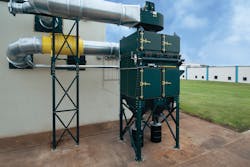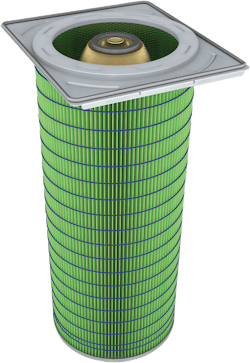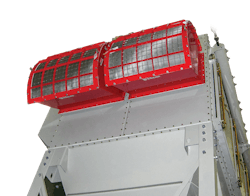Tips for evaluating dust collector system performance
Controlling nuisance, excess, toxic or combustible dust is a common yet serious challenge at processing facilities. Dust not only comes from raw materials, chemicals or ingredients used in production processes, but also from fabrication processes. These include everyday operations such as welding, grinding, blasting, forming, mixing, drying, conveying and blending. Here, dusts can become airborne, endanger air quality and pose fire and explosion hazards.
Effectively controlling dusts generated during industrial operations is a significant health and safety responsibility. A high-efficiency dust collector specifically designed for your processing facility is an accepted and proven engineering control that will improve operations and filter hazardous contaminants and combustible dusts to make indoor environments safer. However, it is important that your dust collector system is designed, installed and maintained to work properly.
When evaluating the performance of your dust collection system, be sure to consider the entire assembly, not just the collector itself. Here are key components and conditions to evaluate, and tips to ensure your dust collection system is working as efficiently as possible.
Filters
Premature failure and frequent change-outs are signs that the air-to-cloth ratio is incorrect (wrong size collector for the application), the wrong filter media is being used or the pulse system isn’t working properly. To maximize the efficiency of the collector and minimize worker exposure, filters should be replaced before they become overladen with dust.
If you notice airflow through the system has reached the differential pressure limit prescribed by the manufacturer, it could be time to change filters. Another sign that you need to change out the filter(s) is a pressure drop across the collector that reduces the system’s ability to capture dust. While some long-life cartridge filters can operate for two years between change-outs, heavy dust-loading applications generally require more frequent filter replacements.
Occasionally, the filter pulse cleaning system may not be working properly. This can indicate a problem with the diaphragm and solenoid valves that regulate pulsing and are critical for proper cleaning to occur, aiding in filter life.
Intake systems and hoods
The structure used to capture the dust, oftentimes a hood, must be sized correctly to achieve the correct capture velocity. If velocities are too low, the system will not effectively collect particles at their source. Velocities that are too high can affect the operation at the collection hood and cause system damage, or inadvertently extract good product from the process.
Ductwork
Heavier dust generally requires higher conveying velocities to keep it suspended while it is moving through the duct to the dust collector. When conveying velocities are too low, the dust particles rest in the ducts or plug them, adding pressure loss and energy cost to the system, but more importantly causing the facility to be noncompliant with combustible dust regulations. Alternatively, if conveying velocities are set too high, the system will have more than the designed loading, possibly decreasing filter life.
If your processes produce combustible dust, the National Fire Protection Association (NFPA) also requires that you protect the ductwork and safety processes upstream of the dust collector. That means equipping the ducting with dampers and isolation valves designed to minimize the risk of deflagration within these components. Adding a flow-activated inlet isolation valve helps to protect upstream work areas when deflagration occurs in a dust collector. During deflagration, the pressure wave closes the valve, preventing the passage of flame and smoke to areas upstream of the valve. The valve latches shut and must be opened manually. The NFPA requires the ductwork between the dust collector and isolation valve to be two times the reduced pressure after venting.
System protection
If your processing operation produces combustible dust, the NFPA requires you to equip your dust collector with deflagration protection. Explosion vents and flameless vents are common, cost-effective methods to help keep your facility and workers safe in the event of a dust collector explosion.
It is essential to understand the pressure capabilities of your dust collector to choose the correct vent size for your system. The enclosure is designed to be stronger than the burst pressure of the vent, while the burst pressure of the vents is lower than that of the vessel. This ensures that the deflagration is relieved of pressure by way of the vent before it can build to levels that would destroy the collector enclosure.
Fans
Be sure fans are sized properly to achieve the system’s required airflow and static pressure/energy. Oversized fans draw too much air into the collector, which raises the air-to-cloth ratio, shortens filter life and increases energy costs. Undersized fans’ conveying velocities are too low in the ducts, causing dust to fall out and build up in the ductwork. Low airflow will prevent the hoods from collecting dust generated during the processing operation.
Hoppers
The hopper is designed to funnel dust to a storage bin. Dust that has accumulated in a hopper creates a significant risk for fire and deflagration. It may also diminish the collector’s performance by clogging the system and preventing the pulse cleaning from performing optimally. Self-dumping hoppers provide easy dust disposal while protecting against unwanted dust leakage, and when partnered with airlocks or slidegates, can be used during operation.
When the hopper is full, detach it from the bottom of the collector, lift the hopper onto a fork truck and pull a lever to swing the lid open and dump the contents into a larger disposal container. Self-dumping hoppers can be used for a range of dry dusts, including those that must be reclaimed or recycled after the collection process. Other options include drums, conveyors or super sacks.
Compressed air system
Another area critical to performance is the compressed air system. If the compressed air pressure is too low, the pulse cleaning system will not clean the filters properly. High moisture levels and/or oil present in the dust can plug the filters, from either the clean or dirty side of the filter. High moisture also can cause problems with the performance and longevity of the solenoid and diaphragm valves. For dust collectors located outdoors, moisture problems in compressed air systems are especially prevalent in cold winter months.
Air quality
Performing regular air quality tests can demonstrate that your facility is meeting OSHA exposure limits for the dusts your processing operation produces. If test results indicate air quality levels outside of the required range, your dust collection system is not doing its job. Your dust collector must be able to achieve the filter efficiency level required to meet OSHA permissible exposure limit (PEL) requirements. OSHA has established PELs based on an eight-hour time-weighted average for hundreds of dusts.
Even if your facility is compliant with PELs set for your dust, some of your workers might still experience dust-related health symptoms. This indicates that your dust collector needs to achieve even lower exposure limits to ensure air quality safety.
Conclusion
Dust control is one of the most difficult challenges in industrial processing. Using a custom-designed and installed high-efficiency dust collection system and keeping it properly maintained by regularly evaluating the entire system will effectively control processing dust. This ensures employee safety from airborne contaminants and helps to achieve regulatory compliance.
Randi Huckaby is Product Manager — Dry Filtration APC Global at Camfil Air Pollution Control. Camfil APC is a global manufacturer of dust, fume and mist collection equipment and part of Camfil, the largest air filter manufacturer in the world.




